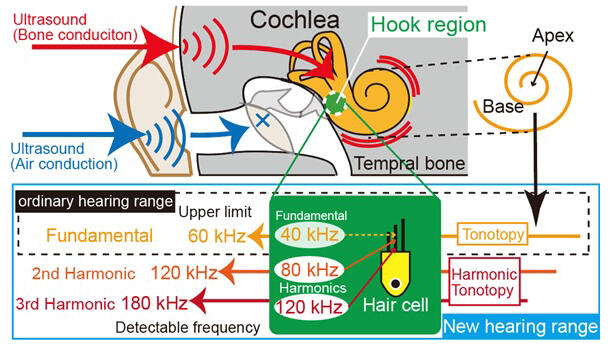It is commonly believed that ultrasonic waves above 20 kilohertz can only be heard by some animals such as dolphins and bats. However, they are also known to be audible to humans when sound stimuli are transmitted through bone. This phenomenon is called ultrasonic hearing, and was discovered 75 years ago, but the mechanism behind it remained poorly understood.
A research group led by Professor Fumiaki Nin from the Graduate School of Medicine at Gifu University and Associate Professor Samuel Choi from the Graduate School of Science and Technology at Niigata University has confirmed for the first time in the world that when the inner ear of guinea pigs is exposed to ultrasound beyond the conventional hearing range of animals, hair cells in the hook region become activated and oscillate at an ultrafast rate in synchronization with the ultrasonic waves. This study revealed that the principle of ultrasonic hearing involves sensing of sound at the frequencies within the conventional hearing range and their integer multiples by hair cells, which recognize audible sound. The work was published in PNAS Nexus.

Provided by Gifu University
In the experiment, guinea pigs under general anesthesia were exposed to ultrasound above the audible range and nerve excitation and hair cell currents were measured. Normally, inaudible ultrasound is perceived only with sound stimulation through the temporal bone; however, ultrasound was perceived when ultrasound stimulation was applied directly to the ossicles, bones in the middle ear.
This result indicates that the cochlea is inherently capable of receiving ultrasound stimuli. Furthermore, optical coherence tomography (OCT) was used to measure the 10-billionth-of-a-millimeter hair cell vibrations evoked by the sound in the hook region. The hook region is where high frequency sounds near the upper limit of the audible range are received. Analysis of these vibrations showed that the hair cells responded to frequencies within the normal audible range as well as to frequencies two and three times higher. This response enables ultrasonic sensing.
The discovery of this new mechanism of receiving sound in the cochlea suggests potential applications for ultrasonic hearing, such as the early diagnosis of hearing loss.
Journal Information
Publication: PNAS Nexus
Title: The cochlear hook region detects harmonics beyond the canonical hearing range
DOI: 10.1093/pnasnexus/pgae280
This article has been translated by JST with permission from The Science News Ltd. (https://sci-news.co.jp/). Unauthorized reproduction of the article and photographs is prohibited.




